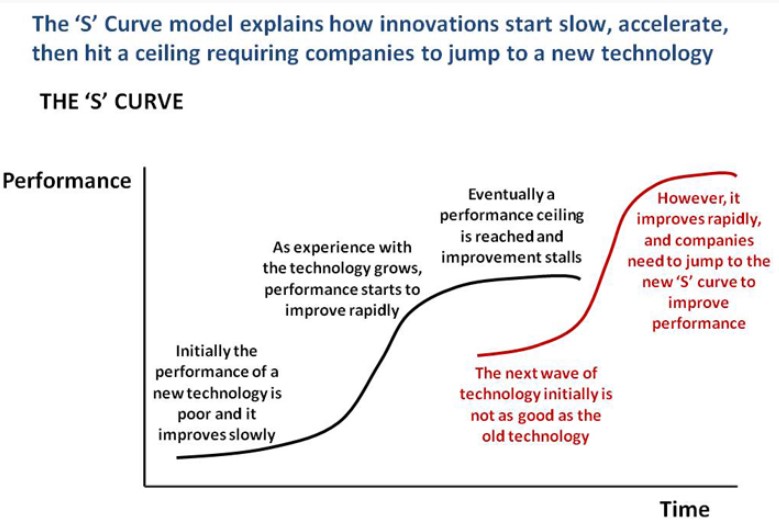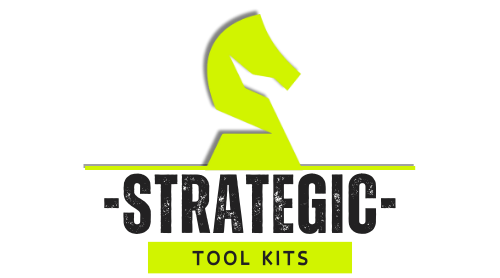The S curve is a strategic concept that describes how the old ways mature and are superseded by new ways.
In the early days of new technology, it takes a long time to improve performance. People are working out the technology, and the applications, ironing out the flaws, and building the ecosystem. Slowly over time, performance accelerates.
After a certain time, the rate of improvement hits a peak and then starts to slow down. Easy wins have all been made and the learning curve has been fully ridden for continuous improvement. Some of the fundamental barriers of the technology are reached. Eventually, the improvement tapers off and a plateau with this technology is reached. This is the “S” shaped curve.
The breakthrough comes when you see a series of S curves. While your existing technology is maturing, there is another technology that is not good enough yet, because it has not been developed, but it has the potential to surpass the ceiling you have reached in your current technology.
The trick for companies is to recognize this and invest in the “worse” emerging technology early enough that they do not get left behind when it accelerates past their current ceiling.

Every business should see its critical S-curve so that they know where they are on it. Should they be investing in continuous improvement to ride the acceleration., or should they be jumping to the next big thing? Jumping to a new S curve is an inflection point for the company.
“Technology” is defined broadly in the context of the S curve. It could mean jumping to a new product technology, process technology, a new business model, a new customer need, or a new basis of competition.
Jumping to a new S curve requires leadership. The whole momentum of the company is invested in the existing technology and they don’t believe the technology is plateauing, and they can prove the new technology is not good enough. Their team has to believe in them and take a jump into the dark.
An Example

Facebook provided a great example of navigating the S-Curve. They were initially conceived as a website for PC/Laptop – they rode this S-curve to rapid growth and maturity. Then a new S-Curve emerged – mobile – which the initial Facebook site did not handle very well. New competitors, designed for mobile, like Instagram and Whatsapp, threatened to capture the new S-curve.
Mark Zuckerberg turned the company just in time. It took a huge effort, to redirect it to mobile with the help of acquisitions of the new competitors.
The Role of Market Research in Identifying New S Curves
Market research is critical for identifying emerging technologies and trends. By continuously monitoring the market, companies can spot potential new S curves early and make informed decisions about where to invest. This involves understanding customer needs, tracking competitors, and staying updated with technological advancements.
Understanding Customer Needs

Market research helps companies understand the evolving needs and preferences of their customers. By conducting surveys, focus groups, and analyzing consumer data, businesses can identify gaps in the market and anticipate future demands. This insight is crucial for recognizing which new technologies or products could fulfill these emerging needs.
Tracking Competitors
Keeping an eye on competitors is essential for identifying potential S curves. By analyzing competitors’ strategies, product launches, and market performance, companies can gain valuable insights into what might work in their industry.
This competitive intelligence helps businesses stay ahead and make strategic decisions about when and where to invest in new technologies.
Staying Updated with Technological Advancements
The rapid pace of technological innovation means that staying informed about the latest advancements is crucial. Market research involves monitoring industry reports, attending conferences, and networking with experts to stay up-to-date with new developments.
This knowledge enables companies to spot emerging technologies early and evaluate their potential impact on their business.
Strategic Planning for S Curve Transitions
Transitioning to a new S curve requires strategic planning. Companies need to allocate resources effectively, develop new competencies, and manage change within the organization. This often involves setting long-term goals, creating detailed action plans, and ensuring alignment across all levels of the organization.
Allocating Resources Effectively

Transitioning to a new S curve often requires significant investment in research and development, new technology, and talent acquisition. Companies must prioritize their resources and ensure they have the necessary budget and personnel to support the transition. This involves making tough decisions about where to cut costs and where to invest more heavily.
Developing New Competencies
Moving to a new S curve may require new skills and capabilities that the organization currently lacks. Strategic planning involves identifying these gaps and implementing training programs, hiring new talent, or partnering with other organizations to develop these competencies. This ensures the company is well-equipped to leverage the new technology or business model.
Managing Change Within the Organization
Change management is a critical aspect of transitioning to a new S curve. Employees may resist new technologies or processes, so it’s essential to communicate the vision clearly and involve them in the transition process. Creating a detailed action plan with clear milestones and regular check-ins can help manage the change effectively and ensure everyone is aligned with the new direction.
The Impact of Organizational Culture on S Curve Adoption
The culture within an organization can significantly impact the adoption of new technologies. A culture that encourages innovation, flexibility, and risk-taking will be more successful in transitioning to new S curves. Leaders must foster an environment where employees feel empowered to experiment and embrace change.
Encouraging Innovation
An innovative culture is one where employees feel free to share ideas and experiment with new approaches. Companies can foster this by creating innovation labs, offering incentives for creative solutions, and celebrating successful innovations. This culture of innovation is essential for identifying and adopting new S curves.
Promoting Flexibility
Flexibility is crucial for adapting to new technologies and processes. Organizations that can quickly pivot and adjust their strategies are better positioned to take advantage of new opportunities. This involves having flexible structures, encouraging cross-functional collaboration, and empowering employees to make decisions quickly.
Taking Well-Calculated Risks
Adopting new technologies often involves a certain level of risk. Organizations that have a culture of calculated risk-taking are more likely to succeed in transitioning to new S curves. Leaders should create an environment where failure is seen as a learning opportunity rather than a setback. This encourages employees to take bold steps and innovate without fear of repercussions.
FAQs
What are the common pitfalls companies face when transitioning to a new S curve?
Common pitfalls include underestimating the time and resources needed for the transition, failing to communicate the vision effectively to employees, and not adequately preparing for resistance to change. Companies may also struggle with balancing investment in the current technology while developing the new one.
How can companies measure their progress on a new S curve?
Companies can measure their progress by setting clear milestones and key performance indicators (KPIs) that align with their strategic goals. Regular reviews and assessments can help track improvements in performance, market adoption, and return on investment (ROI).
What role does leadership play in the successful adoption of new technologies?
Leadership is crucial in driving the vision, fostering a culture of innovation, and managing change. Leaders must communicate the strategic importance of the transition, inspire confidence in their teams, and provide the necessary support and resources to navigate the new S curve successfully.
Can small and medium-sized enterprises (SMEs) effectively navigate S-curve transitions?
Yes, SMEs can navigate S-curve transitions effectively by leveraging their agility and flexibility. They often have fewer bureaucratic hurdles and can make quicker decisions. Strategic partnerships, external funding, and a strong focus on innovation can further support their efforts.
How does customer feedback influence the transition to a new S curve?
Customer feedback is vital for understanding market needs and identifying potential improvements in new technologies or products. Engaging with customers through surveys, focus groups, and beta testing can provide valuable insights that guide the development and refinement of new offerings.
What are the signs that a company is ready to jump to a new S curve?
Signs include reaching a plateau in the performance of the current technology, diminishing returns on investment in continuous improvement, and the emergence of disruptive technologies or market trends. Companies should also consider the competitive landscape and potential threats from new entrants.
Conclusion
Understanding and effectively navigating the S curve is crucial for businesses aiming to stay competitive and innovative. By recognizing where they are on the curve, investing in market research, planning strategically for transitions, and fostering a supportive organizational culture, companies can successfully manage the shift to new technologies and business models.
Leadership plays a vital role in guiding these transitions and ensuring that the organization is well-prepared for future challenges and opportunities.

